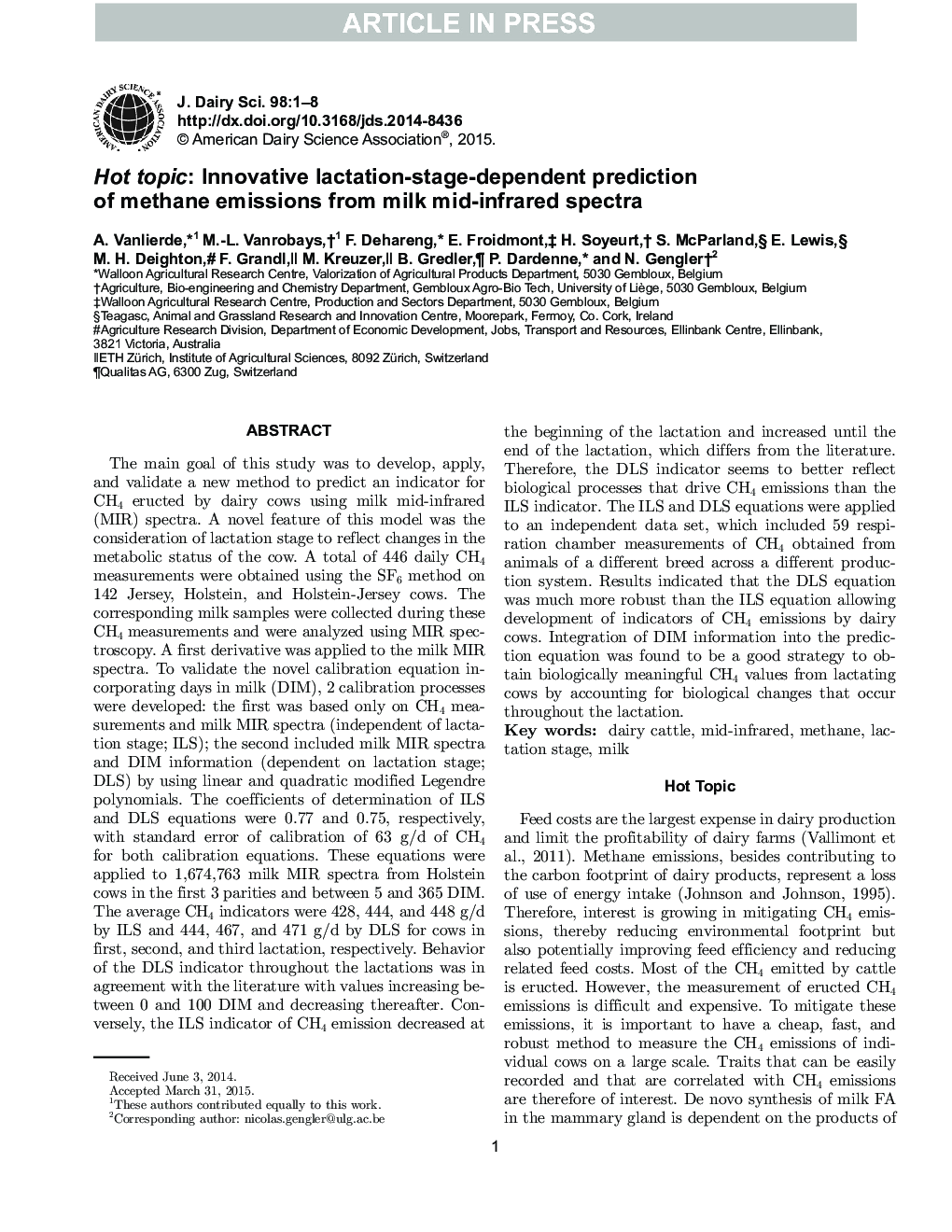| کد مقاله | کد نشریه | سال انتشار | مقاله انگلیسی | نسخه تمام متن |
|---|---|---|---|---|
| 10974264 | 1108023 | 2015 | 8 صفحه PDF | دانلود رایگان |
عنوان انگلیسی مقاله ISI
Hot topic: Innovative lactation-stage-dependent prediction of methane emissions from milk mid-infrared spectra
ترجمه فارسی عنوان
موضوع داغ: پیش بینی وابسته به مرحله شیردهی نوآورانه از انتشار متان از طیف های مادون قرمز شیر
دانلود مقاله + سفارش ترجمه
دانلود مقاله ISI انگلیسی
رایگان برای ایرانیان
کلمات کلیدی
احشام لبنیاتی، مادون قرمز، متان، مرحله شیردهی، شیر،
موضوعات مرتبط
علوم زیستی و بیوفناوری
علوم کشاورزی و بیولوژیک
علوم دامی و جانورشناسی
چکیده انگلیسی
The main goal of this study was to develop, apply, and validate a new method to predict an indicator for CH4 eructed by dairy cows using milk mid-infrared (MIR) spectra. A novel feature of this model was the consideration of lactation stage to reflect changes in the metabolic status of the cow. A total of 446 daily CH4 measurements were obtained using the SF6 method on 142 Jersey, Holstein, and Holstein-Jersey cows. The corresponding milk samples were collected during these CH4 measurements and were analyzed using MIR spectroscopy. A first derivative was applied to the milk MIR spectra. To validate the novel calibration equation incorporating days in milk (DIM), 2 calibration processes were developed: the first was based only on CH4 measurements and milk MIR spectra (independent of lactation stage; ILS); the second included milk MIR spectra and DIM information (dependent on lactation stage; DLS) by using linear and quadratic modified Legendre polynomials. The coefficients of determination of ILS and DLS equations were 0.77 and 0.75, respectively, with standard error of calibration of 63Â g/d of CH4 for both calibration equations. These equations were applied to 1,674,763 milk MIR spectra from Holstein cows in the first 3 parities and between 5 and 365 DIM. The average CH4 indicators were 428, 444, and 448Â g/d by ILS and 444, 467, and 471Â g/d by DLS for cows in first, second, and third lactation, respectively. Behavior of the DLS indicator throughout the lactations was in agreement with the literature with values increasing between 0 and 100 DIM and decreasing thereafter. Conversely, the ILS indicator of CH4 emission decreased at the beginning of the lactation and increased until the end of the lactation, which differs from the literature. Therefore, the DLS indicator seems to better reflect biological processes that drive CH4 emissions than the ILS indicator. The ILS and DLS equations were applied to an independent data set, which included 59 respiration chamber measurements of CH4 obtained from animals of a different breed across a different production system. Results indicated that the DLS equation was much more robust than the ILS equation allowing development of indicators of CH4 emissions by dairy cows. Integration of DIM information into the prediction equation was found to be a good strategy to obtain biologically meaningful CH4 values from lactating cows by accounting for biological changes that occur throughout the lactation.
ناشر
Database: Elsevier - ScienceDirect (ساینس دایرکت)
Journal: Journal of Dairy Science - Volume 98, Issue 8, August 2015, Pages 5740-5747
Journal: Journal of Dairy Science - Volume 98, Issue 8, August 2015, Pages 5740-5747
نویسندگان
A. Vanlierde, M.-L. Vanrobays, F. Dehareng, E. Froidmont, H. Soyeurt, S. McParland, E. Lewis, M.H. Deighton, F. Grandl, M. Kreuzer, B. Gredler, P. Dardenne, N. Gengler,
